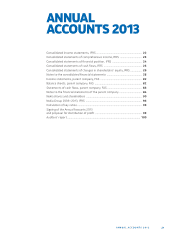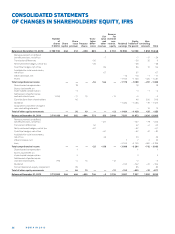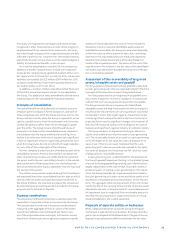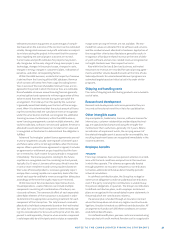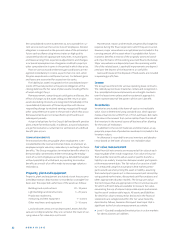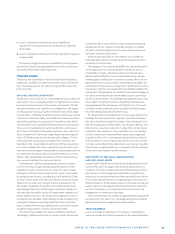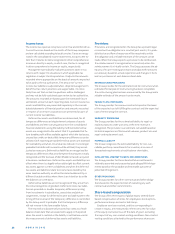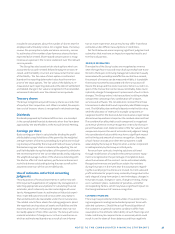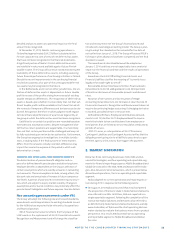Nokia 2013 Annual Report Download - page 31
Download and view the complete annual report
Please find page 31 of the 2013 Nokia annual report below. You can navigate through the pages in the report by either clicking on the pages listed below, or by using the keyword search tool below to find specific information within the annual report.29
NOTES TO THE CONSOLIDATED FINANCIAL STATEMENTS
Previously unrecognized actuarial gains and losses are also
recognized in other comprehensive income. Other long-term
employee benefi ts are required to be measured in the same
way even though changes in the recognized amounts are fully
refl ected in profi t or loss. Treatment for termination benefi ts,
specifi cally the point in time when an entity would recognize a
liability for termination benefi ts, is also revised.
As a result of adopting the revised IAS , the net pension
liabilities and other comprehensive income were impacted
mainly by the retrospectively applied elimination of the ‘corri-
dor’ approach for and . In total, for , net pension
liabilities increased by EUR million (EUR million for )
and other comprehensive income decreased by EUR mil-
lion (EUR million in ), net of tax.
In addition, a number of other amendments that form part
of the IASB’s annual improvement project were adopted by
the Group. The adoption of these amendments did not have a
material impact to the consolidated fi nancial statements.
Principles of consolidation
The consolidated fi nancial statements include the accounts
of Nokia’s parent company (“Parent Company”), and each of
those companies over which the Group exercises control. The
Group controls an entity when the Group is exposed to, or has
right to, variable returns from its involvement with the entity
and has the ability to aff ect those returns through its power
over the entity. The Group’s share of profi ts and losses of
associates is included in the consolidated income statement
in accordance with the equity method of accounting. An as-
sociate is an entity over which the Group exercises signifi cant
infl uence. Signifi cant infl uence is generally presumed to exist
when the Group owns, directly or indirectly through subsidiar-
ies, over % of the voting rights of the company.
All inter-company transactions are eliminated as part of the
consolidation process. Profi t or loss and each component of
other comprehensive income are attributed to the owners of
the parent and to the non-controlling interests. In the consoli-
dated statement of fi nancial position, non-controlling inter-
ests are presented within equity, separately from the equity of
the owners of the parent.
The entities or businesses acquired during the fi nancial peri-
ods presented have been consolidated from the date on which
control of the net assets and operations was transferred to
the Group. Similarly, the results of a Group entity or business
divested during an accounting period is included in the Group
accounts only to the date of disposal.
Business combinations
The acquisition method of accounting is used to account for
acquisitions of separate entities or businesses by the Group.
The consideration transferred in a business combination is
measured as the aggregate of the fair values of the assets
transferred, liabilities incurred towards the former own-
ers of the acquired business and equity instruments issued.
Acquisition-related costs are recognized as expense in profi t
and loss in the periods when the costs are incurred and the
related services are received. Identifi able assets acquired
and liabilities assumed by the Group are measured separately
at their fair value as of the acquisition date. Non-controlling
interests in the acquired business are measured separately
based on their proportionate share of the identifi able net
assets of the acquired business. The excess of the cost of the
acquisition over the interest in the fair value of the identifi able
net assets acquired and attributable to the owners of the par-
ent, is recorded as goodwill.
Assessment of the recoverability of long-lived
assets, intangible assets and goodwill
For the purposes of impairment testing, goodwill is allocated
to cash-generating units that are expected to benefi t from the
synergies of the acquisition in which the goodwill arose.
The Group assesses the carrying amount of goodwill annu-
ally or more frequently if events or changes in circumstances
indicate that such carrying amount may not be recoverable.
The Group assesses the carrying amount of identifi able
intangible assets and long-lived assets if events or changes in
circumstances indicate that such carrying amount may not be
recoverable. Factors that could trigger an impairment review
include signifi cant underperformance relative to historical or
projected future results, signifi cant changes in the manner of
the use of the acquired assets or the strategy for the overall
business and signifi cant negative industry or economic trends.
The Group conducts its impairment testing by determin-
ing the recoverable amount for the asset or cash-generating
unit. The recoverable amount of an asset or a cash-generating
unit is the higher of its fair value less costs of disposal or its
value in use. If there is no reason to believe that the cash-
generating unit’s value in use materially exceeds its fair value
less costs of disposal, the Group may use fair value less costs
of disposal as its recoverable amount.
A cash-generating unit, as determined for the purposes of
the Group’s goodwill impairment testing, is the smallest group
of assets (including goodwill) generating cash infl ows that are
largely independent of the cash infl ows from other assets or
groups of assets. In testing a cash-generating unit for impair-
ment, the Group identifi es all corporate assets that relate to
the cash-generating unit under review and those assets are al-
located, on a reasonable and consistent basis, to the relevant
units. The aggregate total carrying amount of the unit, includ-
ing the portion of the carrying amount of the corporate assets
allocated to the unit, is compared with its recoverable amount.
An impairment loss is recognized if the recoverable amount is
less than the carrying amount. Impairment losses are recog-
nized immediately in the income statement.
Disposals of separate entities or businesses
When a disposal transaction causes the Group to relinquish
control over a separate entity or business, the Group records a
gain or loss on disposal at the disposal date. The gain or loss on
disposal is calculated as the diff erence between the fair value




